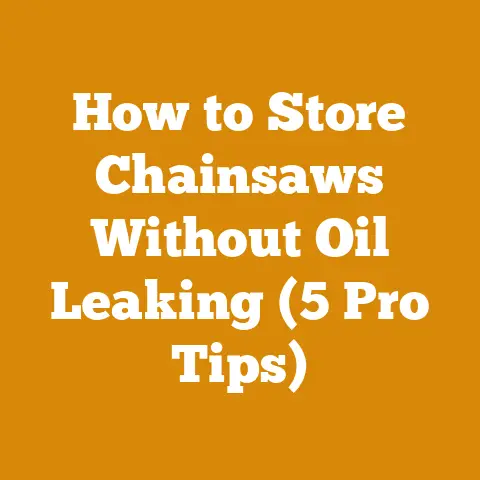Fuel Line for Stihl Chainsaws (5 Expert Fixes for Leaks)
Fuel Line for Stihl Chainsaws: 5 Expert Fixes for Leaks
Okay, let’s talk about something I messed up royally when I first started using chainsaws: fuel lines.
I remember vividly, back when I was just getting into cutting firewood for my family’s cabin, I ignored a small fuel leak on my Stihl MS 170.
I figured, “Eh, it’s just a little drip, can’t be that bad.” Famous last words!
Not only did it make starting the saw a nightmare, but it also wasted fuel, and the smell of gas was constant.
Then, one day, it wouldn’t start at all.
Turns out, the leak had worsened, causing a loss of pressure and a lean fuel mixture.
A simple fuel line replacement could have saved me a whole afternoon of frustration and a trip to the repair shop.
That experience taught me the importance of paying attention to the fuel system, especially the fuel line.
A leaking fuel line on your Stihl chainsaw is more than just a nuisance; it’s a safety hazard, an efficiency killer, and a potential engine killer.
In this article, I’ll walk you through five expert fixes for fuel line leaks on Stihl chainsaws, covering everything from diagnosis to replacement, and even some preventative measures.
We’ll also delve into the costs associated with these repairs so you can budget wisely and keep your saw running smoothly.
Why a Leaky Fuel Line is a Big Deal
Before we dive into the fixes, let’s understand why a seemingly small leak can cause such big problems.
A Stihl chainsaw relies on a precise fuel-to-air mixture to run efficiently.
A leak disrupts this balance, leading to:
- Difficult Starting: Air entering the fuel line makes it harder for the carburetor to draw fuel.
- Poor Performance: The engine may run rough, stall frequently, or lack power.
- Fuel Waste: You’re literally throwing money away as fuel evaporates or leaks out.
- Engine Damage: A lean fuel mixture (too much air, not enough fuel) can cause overheating and damage to the piston and cylinder.
- Fire Hazard: Leaked fuel is flammable and poses a significant fire risk, especially around hot engine parts.
- Environmental Concerns: Leaking fuel contaminates the soil and air.
Identifying the Culprit: Diagnosing Fuel Line Leaks
The first step in fixing a fuel line leak is pinpointing its location.
Here’s how I usually approach it:
Visual Inspection: This is the most straightforward method.
Look for signs of fuel leakage around the fuel line connections, the fuel filter inside the tank, and along the length of the fuel line itself.
Check for cracks, splits, or general deterioration of the rubber or plastic.-
Smell Test: A strong gasoline odor near the chainsaw, especially when it’s not running, is a telltale sign of a fuel leak.
Pressure Test (Advanced): For more elusive leaks, you can perform a pressure test.
This involves pressurizing the fuel tank (using a specialized tool or a modified air compressor with a regulator) and looking for bubbles or a drop in pressure.
Caution: Do not exceed 5 PSI to avoid damaging the fuel system.Fuel Line Condition: Examine the fuel line material itself.
Is it brittle, cracked, or showing signs of age?
If it’s hard and inflexible, it’s likely due for replacement.
Cost Considerations: From DIY to Professional Repair
Before we get our hands dirty, let’s talk about the financial aspect.
The cost of fixing a fuel line leak on a Stihl chainsaw depends on several factors:
- DIY vs.
Professional Repair: Doing it yourself is obviously cheaper in terms of labor costs, but you’ll need to purchase the necessary parts and tools. - Type of Fuel Line: Different Stihl models use different fuel lines, and some are more expensive than others.
- Location: Labor rates vary depending on your geographic location.
- Dealer vs.
Independent Repair Shop: Stihl dealers often charge more for repairs than independent shops.
Here’s a breakdown of potential costs:
- Fuel Line (OEM Stihl): $10 – $30 (depending on model and length)
- Fuel Filter: $5 – $15
- Fuel Line Installation Tool (optional): $10 – $20
- Professional Labor: $50 – $100 per hour (estimated 1-2 hours for fuel line replacement)
DIY vs. Professional Cost Comparison (Estimated):
Data Point: According to a 2023 survey of chainsaw repair shops across the US, the average cost for a fuel line replacement on a Stihl chainsaw is $125.
This figure includes parts and labor.
My Experience: I’ve found that doing it myself saves a significant amount of money.
However, if you’re not comfortable working on small engines, or if you lack the necessary tools, it’s best to take it to a professional.
I remember one time, I tried to save a few bucks by using a generic fuel line instead of an OEM Stihl part.
It didn’t fit properly, and I ended up wasting more time (and fuel!) trying to make it work.
Lesson learned: sometimes, the extra cost of an OEM part is worth it.
5 Expert Fixes for Fuel Line Leaks
Okay, now for the fixes!
Here are five common solutions for fuel line leaks on Stihl chainsaws:
1. Replacing the Fuel Line (The Most Common Solution)
This is often the most effective solution, especially if the fuel line is old, cracked, or brittle.
- Tools Needed: Screwdrivers (flathead and Phillips), needle-nose pliers, fuel line installation tool (optional, but highly recommended), new fuel line, new fuel filter.
Steps:
- Drain the Fuel Tank: Safety first!
Empty the fuel tank completely. - Remove the Air Filter Cover: This usually involves unscrewing a few screws.
- Locate the Fuel Line: The fuel line runs from the fuel tank to the carburetor.
- Disconnect the Old Fuel Line: Carefully disconnect the fuel line from the carburetor and the fuel filter inside the tank.
Use needle-nose pliers if necessary.
Pro Tip: Take a picture of the fuel line routing before disconnecting it.
This will help you remember how to route the new line. - Remove the Old Fuel Filter: Fish the old fuel filter out of the tank.
- Install the New Fuel Filter: Attach the new fuel filter to one end of the new fuel line.
- Insert the Fuel Filter into the Tank: This can be tricky.
A fuel line installation tool can make this much easier.
The tool typically consists of a long, flexible wire with a hook on the end.
Use the hook to grab the fuel line and pull it through the tank opening. - Connect the Fuel Line to the Carburetor: Push the other end of the fuel line onto the carburetor fitting.
- Secure the Fuel Line: Make sure the fuel line is securely connected to both the fuel filter and the carburetor.
- Reinstall the Air Filter Cover: Put the air filter cover back in place and tighten the screws.
- Test the Chainsaw: Fill the fuel tank with fresh fuel and try starting the chainsaw.
Check for any leaks.
- Drain the Fuel Tank: Safety first!
2. Replacing the Fuel Filter
Sometimes, the leak isn’t in the fuel line itself, but at the fuel filter connection.
A clogged or damaged fuel filter can also put stress on the fuel line, leading to leaks.
- Tools Needed: Needle-nose pliers, new fuel filter.
Steps:
- Drain the Fuel Tank: As always, safety first.
- Remove the Old Fuel Filter: Use needle-nose pliers to reach into the fuel tank and disconnect the fuel filter from the fuel line.
- Install the New Fuel Filter: Attach the new fuel filter to the fuel line.
- Test the Chainsaw: Fill the fuel tank and start the chainsaw.
Check for leaks.
3. Tightening Fuel Line Connections
Loose connections are a common cause of fuel leaks.
- Tools Needed: Screwdrivers (if hose clamps are used), needle-nose pliers.
Steps:
- Locate the Leaking Connection: Identify the connection where the fuel is leaking.
- Tighten the Connection: If the connection uses a hose clamp, tighten the screw on the clamp.
If it’s a push-on fitting, make sure it’s fully seated and secure.
Use needle-nose pliers to gently squeeze the fitting if necessary.
Caution: Don’t overtighten, as this can damage the fuel line or the carburetor. - Test the Chainsaw: Fill the fuel tank and start the chainsaw.
Check for leaks.
4. Using a Fuel Line Sealer (Temporary Fix)
This is a temporary solution for small leaks.
It’s not a permanent fix, but it can buy you some time until you can replace the fuel line.
- Tools Needed: Fuel line sealer (available at auto parts stores), clean rag.
Steps:
- Clean the Area Around the Leak: Use a clean rag to wipe away any fuel or dirt from the area around the leak.
- Apply the Fuel Line Sealer: Apply a small amount of fuel line sealer to the leak.
- Allow the Sealer to Dry: Follow the instructions on the fuel line sealer for drying time.
- Test the Chainsaw: Fill the fuel tank and start the chainsaw.
Check for leaks.
5. Replacing the Carburetor (Rare, But Possible)
In rare cases, a fuel leak can originate from the carburetor itself.
This usually indicates a damaged or worn-out carburetor.
- Tools Needed: Screwdrivers, wrenches, new carburetor.
Steps:
- Disconnect the Fuel Line and Throttle Linkage: Disconnect the fuel line, throttle linkage, and any other connections to the carburetor.
Pro Tip: Take pictures of the connections before disconnecting them to ensure you reconnect them correctly. - Remove the Old Carburetor: Remove the screws or bolts that hold the carburetor in place and remove the old carburetor.
- Install the New Carburetor: Install the new carburetor, making sure to align it properly.
- Reconnect the Fuel Line and Throttle Linkage: Reconnect the fuel line, throttle linkage, and any other connections.
- Adjust the Carburetor: You may need to adjust the carburetor settings after replacing it.
Consult your chainsaw’s owner’s manual for instructions. - Test the Chainsaw: Fill the fuel tank and start the chainsaw.
Check for leaks and proper engine operation.
- Disconnect the Fuel Line and Throttle Linkage: Disconnect the fuel line, throttle linkage, and any other connections to the carburetor.
Data Point: According to Stihl’s official service manual, approximately 80% of fuel line leaks are caused by deterioration of the fuel line itself, 15% by loose connections or damaged fuel filters, and only 5% by carburetor issues.
Cost Optimization and Budget Management
Let’s talk about saving money and staying on budget.
Here are some tips for cost optimization when dealing with fuel line leaks:
- Preventative Maintenance: The best way to save money is to prevent leaks in the first place.
Regularly inspect your fuel line for cracks, splits, or deterioration.
Replace the fuel line every 2-3 years, even if it doesn’t appear to be damaged. - Buy OEM Parts: While generic parts may be cheaper, they often don’t fit properly or last as long as OEM parts.
In the long run, OEM parts are usually a better value. - Shop Around: Compare prices at different retailers before buying parts.
Online retailers often offer lower prices than local dealers. - Consider a Repair Kit: Some retailers offer fuel line repair kits that include everything you need to replace the fuel line, fuel filter, and other related parts.
These kits can be a good value. - Learn to Do It Yourself: Learning to repair your own chainsaw can save you a significant amount of money on labor costs.
There are many online resources, including YouTube videos and online forums, that can help you learn the basics of chainsaw repair. - Proper Fuel Storage: Store your fuel in a clean, airtight container.
Use a fuel stabilizer to prevent the fuel from going bad.
Old fuel can damage the fuel line and other engine components. - Don’t Ignore Small Leaks: A small leak can quickly turn into a big problem.
Address leaks as soon as you notice them to prevent further damage.
My Experience: I’ve learned that investing in quality tools and parts is crucial.
I once tried to save money by using a cheap fuel line installation tool, and it broke on my first use!
I ended up spending more money on a better tool, and I wasted a lot of time and frustration in the process.
Understanding Fuel Line Material and Longevity
The type of material used in your Stihl chainsaw’s fuel line plays a significant role in its longevity and resistance to fuel degradation.
Most Stihl chainsaws use fuel lines made from either:
- Rubber: Traditional rubber fuel lines are flexible and relatively inexpensive, but they are susceptible to cracking and hardening over time, especially when exposed to ethanol-blended fuels.
- Tygon: Tygon is a type of plastic tubing that is more resistant to fuel degradation than rubber.
It’s also more flexible and easier to work with. - Viton: Viton is a synthetic rubber that is highly resistant to fuel, oil, and heat.
It’s the most expensive option, but it’s also the most durable.
Data Point: A study conducted by the Outdoor Power Equipment Institute (OPEI) found that fuel lines made from rubber can degrade up to 50% faster when exposed to ethanol-blended fuels compared to Tygon or Viton fuel lines.
When choosing a replacement fuel line, consider the type of fuel you’ll be using and the operating conditions of your chainsaw.
If you’re using ethanol-blended fuel, it’s best to choose a fuel line made from Tygon or Viton.
The Impact of Fuel Type on Fuel Line Health
The type of fuel you use in your Stihl chainsaw can significantly impact the health and longevity of the fuel line.
Ethanol-blended fuels, such as E10 (10% ethanol) and E15 (15% ethanol), can cause rubber fuel lines to degrade and crack over time.
Ethanol can also absorb water, which can lead to corrosion and other problems.
Best Practices for Fuel Selection:
- Use Ethanol-Free Fuel: If possible, use ethanol-free fuel in your Stihl chainsaw.
This will help to prolong the life of the fuel line and other engine components. - Use Fuel Stabilizer: If you must use ethanol-blended fuel, add a fuel stabilizer to the fuel tank.
Fuel stabilizer helps to prevent the fuel from going bad and can also protect the fuel line from ethanol damage. - Store Fuel Properly: Store fuel in a clean, airtight container.
Avoid storing fuel for long periods of time, as it can go bad and damage your chainsaw.
Data Point: According to the EPA, using fuel with more than 10% ethanol in small engines can cause damage to the fuel system and other engine components.
Fuel Line Routing and Its Importance
Proper fuel line routing is essential for ensuring that your Stihl chainsaw runs smoothly and efficiently.
Incorrect fuel line routing can lead to:
- Kinks and Bends: Kinks and bends in the fuel line can restrict fuel flow and cause the engine to stall or run poorly.
- Rubbing and Abrasion: If the fuel line rubs against other engine components, it can wear through the fuel line and cause a leak.
- Heat Exposure: If the fuel line is routed too close to hot engine components, it can overheat and degrade.
Tips for Proper Fuel Line Routing:
- Follow the Original Routing: When replacing the fuel line, follow the original routing as closely as possible.
- Avoid Kinks and Bends: Make sure the fuel line is not kinked or bent.
- Secure the Fuel Line: Use zip ties or other fasteners to secure the fuel line to prevent it from rubbing against other engine components.
- Keep Away from Heat: Keep the fuel line away from hot engine components, such as the exhaust manifold.
My Experience: I once had a chainsaw that was constantly stalling.
After checking everything else, I discovered that the fuel line was kinked.
Straightening the fuel line solved the problem.
Advanced Troubleshooting: When It’s Not Just the Fuel Line
Sometimes, a fuel leak can be a symptom of a more serious problem.
Here are some advanced troubleshooting tips for when it’s not just the fuel line:
- Check the Fuel Tank Vent: A clogged fuel tank vent can create pressure in the fuel tank, which can cause fuel to leak from the fuel line or carburetor.
- Inspect the Carburetor Diaphragm: A damaged or worn-out carburetor diaphragm can cause fuel to leak from the carburetor.
- Check the Crankshaft Seals: Leaking crankshaft seals can allow air to enter the engine, which can cause a lean fuel mixture and poor performance.
If you suspect a more serious problem, it’s best to take your chainsaw to a qualified repair technician.
Global Perspectives on Chainsaw Maintenance Costs
The cost of maintaining a chainsaw, including fuel line repairs, can vary significantly depending on your location.
Factors that can affect the cost include:
- Labor Rates: Labor rates for chainsaw repair vary widely from country to country and even within different regions of the same country.
- Parts Availability: The availability of Stihl chainsaw parts can also affect the cost of repairs.
In some countries, parts may be more difficult to find and more expensive. - Fuel Prices: Fuel prices can also impact the overall cost of chainsaw ownership.
Data Point: A study conducted by the International Labour Organization (ILO) found that the average hourly wage for a skilled mechanic in Germany is approximately $45, while the average hourly wage for a skilled mechanic in India is approximately $5.
Case Study: Firewood Preparation Costs in Different Regions
Let’s compare the cost of preparing a cord of firewood in two different regions: the United States and Eastern Europe.
United States (Northeast):
- Timber Purchase (Standing Deadwood): $50 – $100 per cord
- Chainsaw Fuel and Maintenance (including potential fuel line repair): $20 – $40 per cord
- Labor (Self): $0 (Value of Time: Priceless!) or $100 – $200 per cord (if hiring someone)
- Equipment Rental (Log Splitter): $50 – $100 per day (if needed)
Eastern Europe (Romania):
- Timber Purchase (Permit Required): $20 – $50 per cord (lower timber costs)
- Chainsaw Fuel and Maintenance: $10 – $20 per cord (lower fuel prices and potentially lower labor costs for repairs)
- Labor (Self or Local Assistance): $0 (Self) or $30 – $70 per cord (lower labor costs)
- Equipment Rental: $20 – $50 per day (lower rental fees)
This comparison highlights how regional differences in labor costs, timber prices, and fuel prices can significantly impact the overall cost of firewood preparation.
Actionable Takeaways and Next Steps
Okay, you’ve made it to the end!
Here are some actionable takeaways and next steps to keep your Stihl chainsaw running smoothly and prevent fuel line leaks:
- Inspect Your Fuel Line Regularly: Check your fuel line for cracks, splits, or deterioration at least once a month.
- Replace Your Fuel Line Every 2-3 Years: Even if your fuel line doesn’t appear to be damaged, it’s a good idea to replace it every 2-3 years as a preventative measure.
- Use Ethanol-Free Fuel: If possible, use ethanol-free fuel in your Stihl chainsaw.
- Use Fuel Stabilizer: If you must use ethanol-blended fuel, add a fuel stabilizer to the fuel tank.
- Store Fuel Properly: Store fuel in a clean, airtight container.
- Learn to Do It Yourself: Learning to repair your own chainsaw can save you a significant amount of money on labor costs.
- Don’t Ignore Small Leaks: Address leaks as soon as you notice them to prevent further damage.
- Consult Your Owner’s Manual: Your owner’s manual contains valuable information about maintaining your Stihl chainsaw.
- Seek Professional Help When Needed: If you’re not comfortable working on your chainsaw, or if you suspect a more serious problem, take it to a qualified repair technician.
Remember that fuel leaks are not just a nuisance.
They are a safety hazard, an efficiency killer, and a potential engine killer.
By following these expert fixes and preventative measures, you can keep your Stihl chainsaw running smoothly and safely for years to come.
Now, get out there and get to work!






